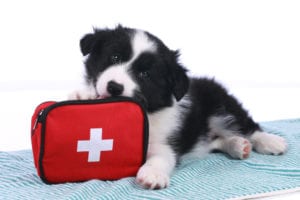 Emergencies can happen at any time. Would you know what to do in case of an emergency with your pet? Here are five great Pet First Aid steps you can take today.
Emergencies can happen at any time. Would you know what to do in case of an emergency with your pet? Here are five great Pet First Aid steps you can take today.
1/ Every home should have a First Aid Kit, including one specifically for pets. Basic Pet First Aid kits are available online and through some veterinary offices, but with a little guidance from your vet, you can easily put together your own.
Remember, emergencies are not always health related, so it’s smart to include important phone numbers (see tip #2), health records, current photo/s, feeding instructions, along with copies of your pet’s registration and microchip numbers.
2/ Keep emergency numbers near your home phone and put them into the contacts list for your cell. Start with your regular veterinarian, the poison control center, plus the nearest 24-hour emergency vet clinic (handy for after hours). If your pet is microchipped (and it should be) be sure to record the actual microchip number. When was the last time you updated the contact information tied to the micrchip? If you’re not sure, check.
National Animal Poison Control Center: 888.426.4435
Pet Poison Helpline: 800.213.6680
3/ Take a Pet CPR class! The American Red Cross and many other organizations offer training and certification classes for Pet CPR. YouTube also has a wealth of video training. Search “Pet CPR classes” plus your city to find a range of resources, both online and off.
4/ Of course there’s an app for that! The American Red Cross offers a free Pet First Aid app for smartphones. Owners have access to step-by-step instructions, videos and images for more than 25 common first aid emergencies. In the interest of being prepared, it might be a good idea to download the one for people, too! Text “GETPET” to 90999, or visit the Apple App Store or Google Play Store for direct downloads.
5. Know when to seek emergency veterinary help. The AVMA (American Veterinary Medical Association) emergency list:
- Severe bleeding or bleeding that doesn’t stop within 5 minutes
- Choking, difficulty breathing, or nonstop coughing and gagging
- Bleeding from nose, mouth, rectum, coughing up blood, or blood in urine
- Inability to urinate or pass feces (stool), or obvious pain associated with urinating or passing stool
- Injuries to your pet’s eye(s)
- You suspect or know your pet has eaten something poisonous (such as antifreeze, xylitol, chocolate, rodent poison, etc.)
- Seizures and/or staggering
- Fractured bones, severe lameness, or inability to move leg(s)
- Obvious signs of pain or extreme anxiety
- Heat stress or heatstroke
- Severe vomiting or diarrhea – more than 2 episodes in a 24-hour period, or either of these combined with obvious illness or any of the other problems listed here
- Refusal to drink for 24 hours or more
- Unconsciousness

